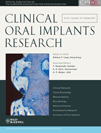A 2-year prospective study on immediate loading with fluoride-modified implants in the edentulous mandible
Abstract
Objectives: Chemically modified surfaces were introduced during the last decade to improve indications for implant treatment. The fluoride-modified implant (Osseospeed®) was launched in 2004 and clinical studies suggest a more rapid bone formation and stronger bone to implant contact. However, limited clinical data are available on marginal bone loss and the outcome after >1 year under immediate loading conditions is not fully understood. Hence, the purpose of this prospective study was to present implant survival and marginal bone level data when fluoride-modified implants are supporting a fully functional rehabilitation from the day after surgery in the completely edentulous mandible.
Materials and methods: Twenty-five patients, completely edentulous in the mandible, were consecutively treated with five fluoride-modified implants that were functionally loaded with a provisional screw retained restoration. Marginal bone loss was measured from day of surgery to 3, 6, 12 and 24 months. Implants were considered successful after 24 months if radiographic bone loss did not exceed 1 mm and no pain or mobility was caused under a torque of 20 N cm. Statistical analysis was carried out on both patient and implant levels.
Results: All implants survived and mean bone loss on implant level after 3, 6, 12 and 24 months was 0.14, 0.13, 0.11 and 0.11 mm, respectively. Bone loss was only statistically significant between baseline and 3 months (P<0.001) and remained unchanged afterward. None of the implants lost >1 mm of bone after 2 years. On the patient level, the mean bone loss after 2 years was 0.12 mm (SD 0.14; range −0.06 to 0.55) with probing pocket depth 2.45 mm (SD 0.43; range 1.3–3.1) and bleeding index 0.55% (SD 0.34; range 0–1).
Conclusion: Immediate loading of fluoride-modified implants is a predictable treatment yielding a high survival and success rate after 2 years.
To cite this article: Collaert B, Wijnen L, De Bruyn H. A 2-year prospective study on immediate loading with fluoride-modified implants in the edentulous mandible.Clin. Oral Impl. Res. 22, 2011; 1111–1116.doi: 10.1111/j.1600-0501.2010.02077.x




